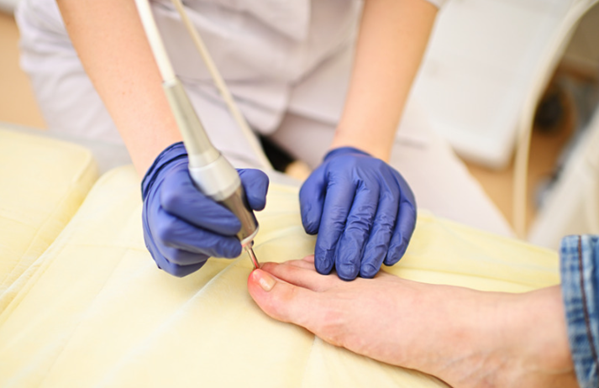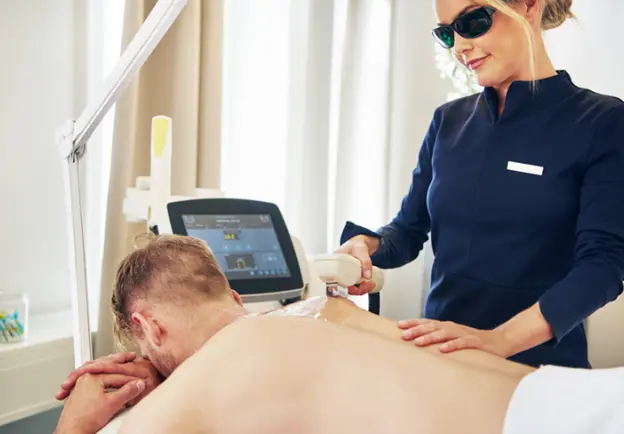Toenail Fungus Explained: Answers to Your Most Common Questions

Toenail fungus, also known as onychomycosis, is a common and persistent condition that affects millions of people worldwide. It is a fungal infection that occurs when microscopic fungi invade the nail bed, causing discoloration, thickening, and brittleness of the toenails. While it may seem like a minor issue, toenail fungus can be a source of significant discomfort, embarrassment, and even lead to more serious complications if left untreated.
In this detailed guide, we explore the essentials of toenail fungus, delving into its causes, symptoms, and particularly focusing on advanced treatment options. We’ll concentrate on laser treatment, one of the most effective and modern solutions available, equipping you with the necessary information to achieve healthy, fungus-free feet.
Understanding Toenail Fungus: An Overview
What causes toenail fungus?
Toenail fungus is primarily caused by a group of fungi called dermatophytes, which thrive in warm, moist environments. These fungi can easily spread through direct contact with infected individuals or by exposure to contaminated surfaces, such as public showers, swimming pools, or locker rooms.
However, certain factors can increase the risk of developing toenail fungus, including:
- Aging: As we grow older, our immune systems become less efficient, making us more susceptible to fungal infections.
- Poor circulation: Conditions that impair blood flow, such as diabetes or peripheral artery disease, can create an environment conducive to fungal growth.
- Weakened immune system: Individuals with compromised immune systems due to conditions like HIV/AIDS or cancer treatments are at a higher risk of developing toenail fungus.
- Excessive sweating: Sweaty feet create a warm, moist environment that fungi love, making it easier for them to proliferate.
- Trauma: Minor injuries or nail-trimming too short can create entry points for fungi to invade the nail bed.
Is toenail fungus contagious?
Yes, toenail fungus is considered a contagious condition. The fungi responsible for the infection can spread from person to person through direct contact or by sharing contaminated items such as towels, socks, or shoes. Additionally, walking barefoot in warm, moist areas like public showers or swimming pools can increase the risk of contracting toenail fungus.
Can toenail fungus be painful?
In its early stages, toenail fungus may not be painful. However, as the infection progresses, it can cause significant discomfort. As the fungus spreads and the nail thickens, it can cause pressure and pain when wearing shoes or engaging in physical activities. In severe cases, the nail may become detached from the nail bed, leading to significant discomfort and potential secondary infections.
Can toenail fungus heal on its own?
In some cases, toenail fungus may resolve on its own without any specific treatment. However, this is relatively rare and often depends on the individual’s immune system and the severity of the infection.
Mild cases of toenail fungus may clear up spontaneously, especially if the underlying cause, such as poor hygiene or trauma, is addressed. However, more severe or chronic cases are unlikely to heal without proper treatment.
It’s important to note that even if the fungus appears to have cleared on its own, there is a high risk of recurrence if the underlying factors that contributed to the infection are not addressed. Additionally, leaving toenail fungus untreated can lead to further complications, such as the spread of the infection to other nails or even the development of secondary bacterial infections.
If you suspect you have toenail fungus, it is always recommended to seek professional medical advice and explore appropriate treatment options to ensure a complete and lasting resolution.
Treatment Options for Toenail Fungus

What is the most effective treatment for toenail fungus?
In its early stages, toenail fungus may not be painful. However, as the infection progresses, it can cause significant discomfort. As the fungus spreads and the nail thickens, it can cause pressure and pain when wearing shoes or engaging in physical activities. In severe cases, the nail may become detached from the nail bed, leading to significant discomfort and potential secondary in
While there are various treatment options available for toenail fungus, the most effective approach often depends on the severity of the infection and individual factors. However, based on extensive research and clinical studies, oral antifungal medications and laser therapy have emerged as the most effective treatments for toenail fungus.
-
Oral Antifungal Medications:
- Terbinafine (Lamisil) and itraconazole (Sporanox) are the most commonly prescribed and effective oral antifungal medications for treating toenail fungus.
- These medications work by targeting and killing the fungus from within, allowing the healthy nail to grow back over time.
-
Laser Treatment:
- Laser therapy is a newer and increasingly popular option for treating toenail fungus.
- This procedure uses targeted laser energy to heat and destroy the fungus without damaging the surrounding healthy tissue.
- Advantages of laser treatment include its non-invasive nature, minimal side effects, and the ability to target the infection directly without systemic exposure to medications.
Additionally, preventive measures, such as maintaining proper foot hygiene and addressing underlying conditions that may contribute to the development of toenail fungus, are crucial for long-term success.
How effective is laser treatment for toenail fungus?
Laser treatment has proven to be a highly effective option for treating toenail fungus, with numerous clinical studies demonstrating its efficacy. The effectiveness of laser treatment is typically measured by the cure rate, which refers to the percentage of patients who achieve complete clearance of the fungal infection after undergoing the treatment.
According to research, the cure rate for laser treatment of toenail fungus ranges from 60% to 80%, depending on the severity of the infection and the number of treatment sessions received.
If you are considering laser treatment for toenail fungus, it is essential to consult with a qualified podiatrist or dermatologist who can evaluate your condition and determine if this treatment option is appropriate for you. They can also provide you with realistic expectations regarding the effectiveness and potential outcomes of the treatment.

How many laser treatments for toenail fungus are needed?
The number of laser treatments required for toenail fungus can vary depending on the severity of the infection and the individual’s response to the treatment. Generally, most patients require multiple laser treatment sessions to achieve optimal results.
Typically, 2 to 3 laser treatment sessions are recommended for mild and moderate infections, spaced 4 to 8 weeks apart, allowing time for the healthy nail to grow out and the fungus to be gradually eliminated. For severe or chronic cases, 3 to 4 laser treatment sessions may be necessary, spaced 6 to 8 weeks apart, to ensure adequate time for the treatment to take effect and the healthy nail to grow out.
How much does it cost for laser toenail fungus treatment?
The cost of laser toenail fungus treatment can vary depending on several factors, including the geographic location, the expertise and reputation of the provider, and the number of treatments required. However, it is generally considered a more expensive option compared to traditional treatments like oral antifungal medications or topical treatments.
It’s important to discuss the potential costs with your healthcare provider and inquire about any available payment plans or financing options. Additionally, it’s advisable to check with your insurance provider to understand the extent of coverage for laser toenail fungus treatment and any out-of-pocket expenses you may need to plan for.
While the cost of laser treatment may be higher than some other treatment options, many patients find it a worthwhile investment for the potential benefits of effectively eliminating stubborn toenail fungus and achieving healthy, fungus-free nails.
Post-Laser Treatment Care for Toenail Fungus
Following laser treatment for toenail fungus, it’s crucial to adhere to your healthcare provider’s instructions and attend all scheduled sessions to ensure the best possible outcome. Consistency and patience are key, as it can take several months for the healthy nail to fully grow out and replace the infected portion.
Regular follow-up appointments are essential to monitor progress and catch any potential recurrences or complications early. With proper care and adherence to the recommended treatment plan, laser therapy can be an effective solution for achieving fungus-free, healthy toenails.
In addition to attending your laser sessions, maintaining proper foot hygiene and making necessary lifestyle modifications are vital. Keep your feet clean and dry, wear breathable socks and shoes, and avoid walking barefoot in public areas. Manage any underlying conditions like diabetes, avoid tight-fitting shoes, and consider using antifungal powders or sprays in your footwear to prevent recurrence.
By combining laser treatment with these practices, you can maximize your chances of achieving and maintaining healthy, fungus-free toenails
Where to get laser treatment for toenail fungus?
If you’re considering laser treatment for toenail fungus, it’s important to seek out qualified and experienced healthcare professionals who specialize in this advanced treatment modality.
Some clinics and medical centers specialize in laser treatments for various conditions, including toenail fungus. These clinics often have state-of-the-art laser equipment and staff trained specifically in laser therapy procedures.
When choosing a provider for laser toenail fungus treatment, it’s essential to consider the following factors:
- Experience and Expertise: Look for healthcare professionals who have extensive experience and specialized training in laser therapy for toenail fungus. Inquire about their success rates and the number of laser treatments they have performed.
- Credentials and Certifications: Ensure that the provider you choose is properly licensed and certified to perform laser treatments. This ensures that they meet the necessary qualifications and adhere to safety standards.
- Equipment and Technology: Inquire about the specific laser technology and equipment used by the provider. Advanced laser systems designed specifically for toenail fungus treatment may offer better results and a more comfortable experience.
- Patient Reviews and Testimonials: Read patient reviews and testimonials to gain insights into the provider’s bedside manner, communication skills, and overall patient satisfaction.
- Insurance Coverage: If you have health insurance, check with your provider to understand their coverage policies for laser toenail fungus treatment. This can help you make an informed decision based on potential out-of-pocket costs.
By carefully researching and selecting a qualified and experienced provider, you can increase your chances of achieving successful results and a positive experience with laser treatment for toenail fungus.
Urban Body Laser: Your Path to Fungus-Free Feet
At Urban Body Laser, we provide cutting-edge laser treatments for toenail fungus, utilizing the latest FDA-approved technology. Our experienced team offers personalized care in a modern, welcoming environment, ensuring effective fungal elimination with minimal discomfort.
During your initial consultation, we evaluate your condition and create a tailored treatment plan. Our state-of-the-art laser systems precisely target the fungus, promoting healthy nail growth.
Committed to safety, quality, and patient satisfaction, we maintain the highest standards of cleanliness and care. Join our satisfied patients who have regained their confidence with our effective treatments.
Say goodbye to toenail fungus and hello to healthy feet with Urban Body Laser. Schedule your consultation today by calling 604 696 5506 or contacting us.





